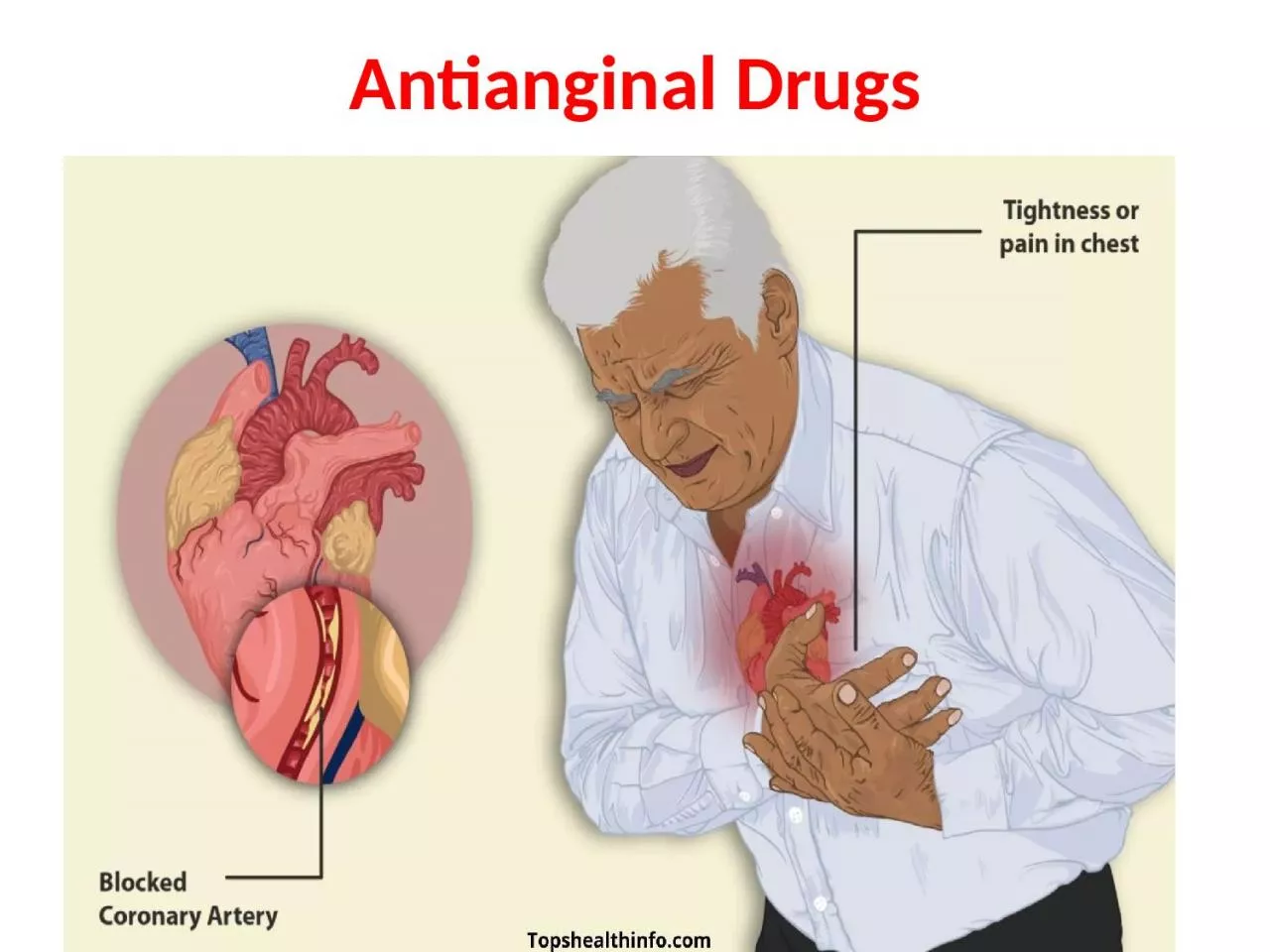

Atherosclerotic disease of coronary arteries is the most common cause of mortality Imbalance in myocardial oxygen supply amp demand Stable angina effortinduced shortlasting promptly relieved by rest or nitroglycerin ID: 1044904
Download Presentation The PPT/PDF document "Antianginal Drugs Angina Pectoris" is the property of its rightful owner. Permission is granted to download and print the materials on this web site for personal, non-commercial use only, and to display it on your personal computer provided you do not modify the materials and that you retain all copyright notices contained in the materials. By downloading content from our website, you accept the terms of this agreement.
1. Antianginal Drugs
2. Angina Pectoris Atherosclerotic disease of coronary arteries is the most common cause of mortalityImbalance in myocardial oxygen supply & demandStable angina: effort-induced, short-lasting, promptly relieved by rest or nitroglycerinUnstable angina: severe angina ˃20 minutes, not relieved by rest or nitroglycerin. Need hospital.Prinzmetal, variant, vasospastic angina: spasm of coronary arteries at rest. Promptly relieved by nitroglycerin & calcium channel blockers.
3. Treatment strategies:Four types of drugs are commonly used alone or in combination: ß-blockers, calcium channel blockers, organic nitrates, and sodium channel blocker (ranolazine)
4. β-adrenergic blockersβ-blockers decrease oxygen demands of myocardium by blocking β1 receptors→↓HR, contractility, COP, & BP. ↑ coronary perfusion time during diastole? β-blockers are recommended as initial antianginalBut should be avoided in Prinzmetal angina?β-blockers improve survival in prior MI & HF?β-blockers with ISA (pindolol) are avoided?Cardio-selective are preferred?Avoid abrupt withdrawal? Tapering 2-3 wks
5. Calcium channel blockers (CCB)The intracellular concentration of calcium plays an important role in maintaining the tone of smooth muscle and in the contraction of the myocardium.Calcium channel antagonists block the inward movement of calcium by binding to calcium channels in the heart and in smooth muscle of the coronary and peripheral arteriolar vasculature.This causes vascular smooth muscle to relax, dilating mainly arterioles. Calcium channel blockers do not dilate veins.
6. Calcium channel blockers (CCB)Calcium is essential for muscular contraction & its influx is increased in ischemia (worse effect).CCB protect tissues by inhibiting calcium entranceAll CCB are arteriolar & coronary vasodilators→↓resistance & afterload &↓BPUseful in vaso-spastic angina (coronary vasodilation)Verapamil mainly on myocardium, amlodipine greatly peripheral. Diltiazem is intermediate
7. Dihydropyridine CCBAmlodipine has minimal effect on cardiac conductionMain function is arteriolar vasodilatorUseful in variant anginaNifedipine (extended release formulation) Short acting should be avoided in angina (increased mortality?)All CCBs are useful in the reatment of angina. In addition, nondihydropyridine CCB: diltiazem and verapamil are used in the treatment of atrial fibrillation & supraventricular tachycardia (SVT)
8. Nondihydropyridine CCBVerapamil slows atrioventricular (AV) coduction, and decreasing HR, contractility, BP & oxygen demandVerapamil has greater negative inotropic effects than amlodipine, but weaker vasodilatorVerapamil is contraindicated in HF or AV conduction abnormality & never combined with β-blockers?.Diltiazem also slows AV conduction & firing of sinus node. It is also coronary vasodilator & is particularly useful for variant angina.
9. Organic nitratesMechanism of action:Relax vascular smooth ms by release of nitric oxide (NO) by mitochondrial aldehyde dehydrogenase (ALDH).NO activates guanylate cyclase & ↑ synthesis of cyclic guanosine monophosphate (cGMP)cGMP →dephosphorylation of myosin light chain, resulting in vasodilation.Nitrates cause venodilation & reduce preload & then work of the heartAlso dilate coronary vessels, increasing bl. supply
10. Onset of action1 minute for sublingual nitroglycerin (tablet or spray) 30 min. for transdermal (patch or ointment) nitroglycerine or sustained release tablets of isosorbide mononitrate or dinitrate.Nitroglycerin (GTN, Angised) exposed to significant first pass metabolism in the liverAdverse effects:Throbbing headache is the most common (meningeal vasdilation).Postural hypotension, facial flushing & reflex tachycardia Nitrate tolerance
11. Nitroglycerin (GTN, Angised)
12. Phosphodiesterase 5 inhibitors (Sildenafil, Viagra) potentiate the nitrate action, causing dangerous hypotention. This combination is contraindicatedTolerance to nitrate action develops rapidly as blood vs. become desensitized to vasodilation. Due to oxidation of mitochondrial ALDH enzyme by NO. Nitrate-free interval to restore sensitivity to nitrate action. 10-12 hrs usually overnight night when oxygen demand is decreased .Variant angina worsens early morning → late afternoon free interval
13. Sodium channel blockerRanolazine Inhibits the late phase of sodium current & reduces intracellular Na & Ca. Thereby improving diastolic function & improving oxygen supply & demand.Used when other antianginals are failedNumerous drug interactions & can prolong QT interval.
14. Conclusion
15. Antianginal in relation to comorbidity
16. MCQWhich drug should be prescribed to all angina patients in acute attack?Isosorbide mononitrateIsosorbide dinitrateNitroglcerin patchSublingual nitroglycerinRanolazine
17. MCQA 60 year-old man diagnosed as angina. Atenolol & nitroglycerin were prescribed. Which of his current medications should be discontinued?AspirinLisinoprilMetforminAmlodipineSildenafil (Viagra)
18. MCQWhich of the following correctly ranks from most active on myocardium to most peripherally active?Diltiazem, amlodipine, verapamilVerapamil, diltiazem, AmlodipineNifedipine, verapamil, diltiazemAmlodipine, diltiazem, verapamilDiltiazem, verapamil, nifedipine
19. MCQWhich is correct regarding antianginal therapy in patient with angina & heart failure?Metoprolol has been associated with reduced mortalityAmlodipine should be avoidedPindolol is the preferred β-blockerVerapamil should be used in patient who can not tolerate β-blockers Nitrates are contraindicated
20. MCQFifty year old patient with severe bronchial asthma, developed angina pectoris. The following drug is preferred initial therapy with nitroglycerine for such patient.Propranolol Verapamil Ranolazine Pindolol